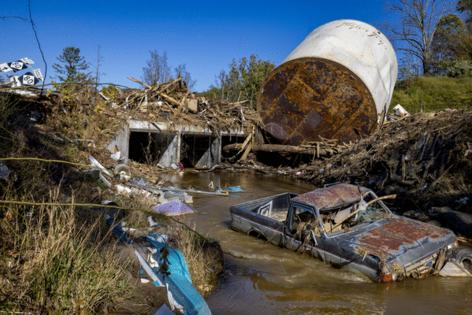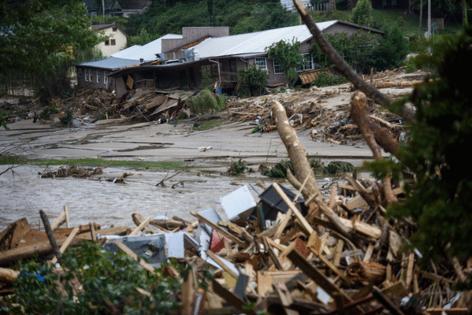Helene cements North Carolina as a target for 'disaster tourism'
Published in News & Features
CHARLOTTE, N.C. — Jess Fager was not surprised when her Swannanoa home drew a steady parade of gawkers, smartphones raised, fascinated by the crumbled walls and devastation that Hurricane Helene inflicted on her purple bungalow.
But it’s been nearly a year since floodwaters crashed through her house and months since the repairs were finished, and Fager still finds herself staring into the lens of a camera when she looks out the window.
“I think we’re just going to have to live with it,” she said. “People are too interested in what happened.”
Fager, like many survivors, sees the attention as an unsettling aftershock of Helene, one that lingers even after the wreckage is cleared. She wonders when public curiosity will wane, when her community will be defined by more than its suffering.
Experts warn North Carolina has joined the ranks of global destinations marked by catastrophe — places where tragedy isn’t a deterrent but the reason people come. Helene has cemented the Tar Heel state as a target for disaster tourism, a cultural phenomenon that recasts war zones as holiday destinations and slots concentration camps onto bucket lists.
“People love the thrill of a scare and they love to know that they’re going to see this horrible thing from the safety of time,” said Beth Heidelberg, a professor of urban studies at Minnesota State University in Mankato. “The closest they can come is trying to immerse themselves in the culture in the context of what happened.”
The motivations behind the disaster tourists vary, said Heidelberg, who has spent more than a decade researching how local governments respond to disaster tourism. Some visitors come with empathy, hoping to better grasp a disaster they’ll never truly experience, while others arrive seeking spectacle, indifferent to the pain left behind.
But for locals still rebuilding homes and grieving loved ones, intent doesn’t lessen the invasion. The attention, they say, drags them back to the worst days, reviving a powerlessness they’ve worked hard to forget.
“It feels like a mockery,” said Lydia Huntley, a lifelong Swannanoa resident who weathered the storm from the Beacon Village house where she’s lived for 68 years. “Why would you want to take pictures or look at such devastation, knowing that people lost their homes, lost their lives, lost friends?”
It wasn’t until after the storm, said Huntley, that cars began clogging the roads she’d driven for decades. In the months following Helene, traffic crawled for miles beside ravaged neighborhoods as drivers slowed down for a look, turning Huntley’s 10-minute trip to Asheville into an hour-long commute.
It became such a nuisance that Asheville resident Nathan Phillips mounted five metal signs along thoroughfares near his neighborhood, urging drivers not to stop and film.
“People thought it was OK to park in the middle of an active road and stand there and take pictures and complicate cleanup while people were running around trying to rebuild their lives,” said Phillips. “I guess some people think it’s OK to get in the way.”
While crowds trespassing onto properties in Swannanoa have dwindled, said Fager, who estimates daily out-of-towners have dropped from hundreds to just a few, she still dodges drivers too focused on filming to watch the road.
She’s accepted the attention as another consequence of the storm, one that experts say is embedded in communities around the world that have survived hurricanes. Today, disaster seekers pack tours through New Orleans neighborhoods devastated by Hurricane Katrina two decades ago, and visitors continue to flock to Galveston to see the legacy of a hurricane that killed thousands more than a century earlier.
“Even after the community is restored, people are still going to be curious,” said Heidelberg. “It can linger in the public consciousness for ages.”
Some communities are taking steps to get ahead of the onslaught. Earlier this month, the Los Angeles City Council unanimously voted to restrict commercial tours in Pacific Palisades, where busloads of tourists pass through neighborhoods to glimpse the aftermath of January’s devastating wildfires. Just days later, Texas emergency officials urged the public to avoid areas along the Guadalupe River, where floods killed more than 100 people, warning that disaster tourism could hinder rescue efforts.
But there are ways for locals to reclaim that attention for their own benefit. Done thoughtfully, said Heidelberg, disaster tourism can become part of the healing process.
Directing disaster tourists to one spot
Last September, local officials assumed the mud and debris in Marshall would be enough to keep tourists away. But the need for security became clear when crowds headed downtown, eager for a closer look at the battered buildings Helene left behind.
Barriers were installed to block traffic, and volunteers joined law enforcement to monitor areas where tourists tried to slip through, said Bill Downey, director of Madison County’s Visitor Center. Downtown is now open and welcoming to visitors, but Downey said many residents remain wary of disaster tourists.
“I kind of understand the curiosity, it’s just a little insensitive,” said Downey. “Immediately following a natural disaster, it was pretty inappropriate.”
Like many nearby communities, Madison County has centered its messaging on resilience and readiness for visitors. But cleanup and repair isn’t enough to satisfy some disaster tourists, experts say, prompting them to drift through neighborhoods in search of lingering damage.
Heidelberg said tourism authorities and local governments can channel that curiosity by offering designated outlets, redirecting inevitable disaster tourists away from places where they’re not welcome. The challenge, she said, is overcoming the stigma of capitalizing on the phenomenon.
“They’re afraid of being labeled as exploitative, or as trying to make money and revenue off the backs of the dead,” said Heidelberg. “It’s a very awkward, uncomfortable concept, but a reality.”
In Massachusetts, officials purchased property in Salem for an interpretive museum that gave tourists a respectful way to learn about the execution of innocent women. Down the street from the crash site of Pan Am Flight 103, a transatlantic flight brought down by a terrorist bomb in 1988, a small church in Scotland now serves as an information center, offering detailed information about those who lost their lives in the attack.
When implemented correctly, Heidelberg said these spaces allow authorities to educate visitors while guiding their attention away from sites where it might cause harm. Lacking direction, tourists tend to search elsewhere for answers, and respect doesn’t always accompany that curiosity.
“It’s so sad and it’s so heartbreaking,” said Miranda Escalante, an Asheville bartender who said patrons are constantly asking where they can go to find wreckage. “Don’t ask about our trauma because it’s not very fair to ask us to consistently relive that,” said Ida DeZwaan, who reports similar behavior at the restaurant she manages in Hendersonville.
In communities planning to memorialize the storm, few officials are thinking about disaster tourists. Madison County’s one-year anniversary event in September will focus on showcasing the area’s recovery, said Downey, and officials in Chimney Rock are working on a tribute to a resident who died in the storm.
Don Cason, the executive director for Rutherford County’s Tourism Development Authority, said he has no plans to “bring people in and show them what our devastation is,” or to “try to make money on showing others our disaster.” His focus is on rebuilding, and for Cason, that means deeming the storm a thing of the past.
But climate disasters are anything but, said Freya Higgins-Desbiolles, who grew up south of Wilmington and now lives in Australia, where she’s spent more than three decades studying disaster tourism. She warns that to protect one of North Carolina’s most profitable industries, recovery planning must become a permanent part of the strategy.
Most residents recognize the importance of tourism, especially in communities where peak seasons sustain small businesses through the year. But not everyone is ready to welcome outsiders back after a disaster, and Higgins-Desbiolles said it’s common for local voices to be overlooked in the rush to recover lost revenue.
“These climate change disasters can happen anywhere and are becoming less predictable,” said Higgins-Desbiolles, an adjunct professor at The University of South Australia. “The tourism industry is going to have to be much more proactive for its future of working with communities.”
Getting residents’ input
When the officers strapped with machine guns left their guard posts along the highway between Bat Cave and Chimney Rock — a stretch still closed to everyone but locals — April Bolet didn’t expect much to change. The barricades, she said, remain nearly impossible to miss, marked with bright orange signs that stretch across each end.
But it didn’t take long for out-of-state plates to start showing up. First South Carolina, then Florida, Tennessee, and Georgia. The latest visitors, Bolet said, have been motorcyclists, weaving through barriers with cameras in hand.
“They’re going so slow and then they’re pointing at everything, which tells me they’ve never been here before,” said Bolet, who lives in Bat Cave, an unincorporated community in Henderson County and one of the areas hit hardest by Helene. “People are already testing the waters.”
Others in the small mountain town have also noticed more banned vehicles slipping past the barriers, an issue they fear could intensify once the road actually reopens. Each outsider is a jarring reminder of how far there is to go, and Bolet says the added traffic could complicate an already difficult recovery.
“Hopefully we get boring, and it doesn’t become a sightseeing adventure,” she said. “But we need the tourists, so it’s kind of a double-edged sword.”
Higgins-Desbiolles says including local voices in tourism planning is often overlooked by industry officials. She believes it’s the most effective way to reopen a community with sensitivity to those still grieving and with benefits for everyone involved.
“If tourism is not well managed and the local people get angry, then the destination’s reputation becomes damaged,” she said. “There are such more positive ways to manage what is a tense situation.”
Many local officials say they’ve been working since September to initiate these conversations with locals. In Chimney Rock Village, Cason said both residents and business owners have had multiple opportunities to contribute to Rutherford County’s rebuilding plan.
Buncombe County’s tourism department, tasked with attracting visitors and promoting local businesses, is staffed by residents and focused on aligning its messaging with community needs. The department has encouraged tourism in areas equipped to handle it, aiming to support recovery without overwhelming vulnerable neighborhoods.
“It’s a balance of our people and places and spaces,” said Vic Isley, president and CEO of Explore Asheville.
Chimney Rock officials acknowledge residents’ concern about the rise in vehicles ignoring traffic rules, but they say enforcing restrictions has been difficult. The road in question is technically a state highway, said Village Administrator Stephen Duncan, even though it’s currently open only to local traffic.
Leaders recently passed an ordinance allowing officers to enforce the Village’s traffic regulations, a step Duncan hopes will help reduce roadside pullovers and photo stops. Still, his focus remains on the pristine downtown streets and the new sewer systems set to restore water to the area this month.
Duncan has been advocating for the community since 1995, when he brought drafted ordinances to the General Assembly and officially established the Village as a town. Helene didn’t break Chimney Rock, and when downtown opens, Duncan doesn’t care who comes to visit.
“We want these people to come in here and get out of their cars and shop,” he said. “They can look all they want.”
_____
©2025 The Charlotte Observer. Visit charlotteobserver.com. Distributed by Tribune Content Agency, LLC.










Comments